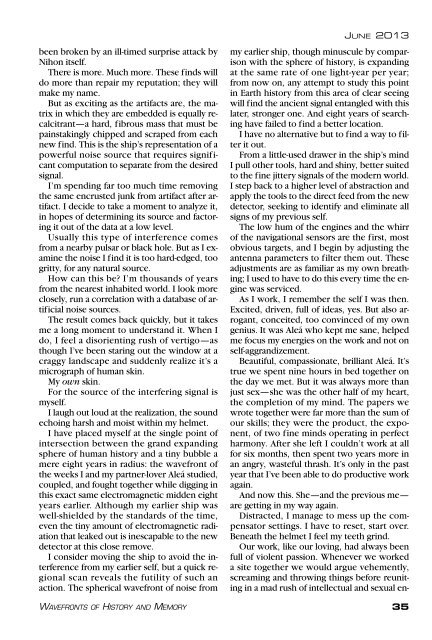Analog Science Fiction and Fact - June 2013
Analog Science Fiction and Fact - June 2013
Analog Science Fiction and Fact - June 2013
Create successful ePaper yourself
Turn your PDF publications into a flip-book with our unique Google optimized e-Paper software.
een broken by an ill-timed surprise attack by<br />
Nihon itself.<br />
There is more. Much more. These finds will<br />
do more than repair my reputation; they will<br />
make my name.<br />
But as exciting as the artifacts are, the matrix<br />
in which they are embedded is equally recalcitrant—a<br />
hard, fibrous mass that must be<br />
painstakingly chipped <strong>and</strong> scraped from each<br />
new find. This is the ship’s representation of a<br />
powerful noise source that requires significant<br />
computation to separate from the desired<br />
signal.<br />
I’m spending far too much time removing<br />
the same encrusted junk from artifact after artifact.<br />
I decide to take a moment to analyze it,<br />
in hopes of determining its source <strong>and</strong> factoring<br />
it out of the data at a low level.<br />
Usually this type of interference comes<br />
from a nearby pulsar or black hole. But as I examine<br />
the noise I find it is too hard-edged, too<br />
gritty, for any natural source.<br />
How can this be? I’m thous<strong>and</strong>s of years<br />
from the nearest inhabited world. I look more<br />
closely, run a correlation with a database of artificial<br />
noise sources.<br />
The result comes back quickly, but it takes<br />
me a long moment to underst<strong>and</strong> it. When I<br />
do, I feel a disorienting rush of vertigo—as<br />
though I’ve been staring out the window at a<br />
craggy l<strong>and</strong>scape <strong>and</strong> suddenly realize it’s a<br />
micrograph of human skin.<br />
My own skin.<br />
For the source of the interfering signal is<br />
myself.<br />
I laugh out loud at the realization, the sound<br />
echoing harsh <strong>and</strong> moist within my helmet.<br />
I have placed myself at the single point of<br />
intersection between the gr<strong>and</strong> exp<strong>and</strong>ing<br />
sphere of human history <strong>and</strong> a tiny bubble a<br />
mere eight years in radius: the wavefront of<br />
the weeks I <strong>and</strong> my partner-lover Aleá studied,<br />
coupled, <strong>and</strong> fought together while digging in<br />
this exact same electromagnetic midden eight<br />
years earlier. Although my earlier ship was<br />
well-shielded by the st<strong>and</strong>ards of the time,<br />
even the tiny amount of electromagnetic radiation<br />
that leaked out is inescapable to the new<br />
detector at this close remove.<br />
I consider moving the ship to avoid the interference<br />
from my earlier self, but a quick regional<br />
scan reveals the futility of such an<br />
action. The spherical wavefront of noise from<br />
WAVEFRONTS OF HISTORY AND MEMORY<br />
JUNE <strong>2013</strong><br />
my earlier ship, though minuscule by comparison<br />
with the sphere of history, is exp<strong>and</strong>ing<br />
at the same rate of one light-year per year;<br />
from now on, any attempt to study this point<br />
in Earth history from this area of clear seeing<br />
will find the ancient signal entangled with this<br />
later, stronger one. And eight years of searching<br />
have failed to find a better location.<br />
I have no alternative but to find a way to filter<br />
it out.<br />
From a little-used drawer in the ship’s mind<br />
I pull other tools, hard <strong>and</strong> shiny, better suited<br />
to the fine jittery signals of the modern world.<br />
I step back to a higher level of abstraction <strong>and</strong><br />
apply the tools to the direct feed from the new<br />
detector, seeking to identify <strong>and</strong> eliminate all<br />
signs of my previous self.<br />
The low hum of the engines <strong>and</strong> the whirr<br />
of the navigational sensors are the first, most<br />
obvious targets, <strong>and</strong> I begin by adjusting the<br />
antenna parameters to filter them out. These<br />
adjustments are as familiar as my own breathing;<br />
I used to have to do this every time the engine<br />
was serviced.<br />
As I work, I remember the self I was then.<br />
Excited, driven, full of ideas, yes. But also arrogant,<br />
conceited, too convinced of my own<br />
genius. It was Aleá who kept me sane, helped<br />
me focus my energies on the work <strong>and</strong> not on<br />
self-aggr<strong>and</strong>izement.<br />
Beautiful, compassionate, brilliant Aleá. It’s<br />
true we spent nine hours in bed together on<br />
the day we met. But it was always more than<br />
just sex—she was the other half of my heart,<br />
the completion of my mind. The papers we<br />
wrote together were far more than the sum of<br />
our skills; they were the product, the exponent,<br />
of two fine minds operating in perfect<br />
harmony. After she left I couldn’t work at all<br />
for six months, then spent two years more in<br />
an angry, wasteful thrash. It’s only in the past<br />
year that I’ve been able to do productive work<br />
again.<br />
And now this. She—<strong>and</strong> the previous me—<br />
are getting in my way again.<br />
Distracted, I manage to mess up the compensator<br />
settings. I have to reset, start over.<br />
Beneath the helmet I feel my teeth grind.<br />
Our work, like our loving, had always been<br />
full of violent passion. Whenever we worked<br />
a site together we would argue vehemently,<br />
screaming <strong>and</strong> throwing things before reuniting<br />
in a mad rush of intellectual <strong>and</strong> sexual en-<br />
35

















